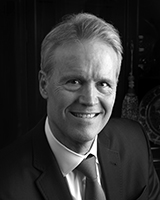
David B. Hellmann,
MD, MACP
As a high school physics student, I remember being gobsmacked by the idea of “escape velocity.” For those who haven’t cracked a physics textbook in a while, here’s a quick refresher: If you want to leave Earth to travel to the moon or to orbit our fine planet, you can’t do it by traveling at 500 mph, or 1,000 mph or even 10,000 mph. Escaping Earth’s gravitational pull requires reaching escape velocity — which scientists have measured to be a whopping 25,000 mph.
That’s indeed a dramatic acceleration. But then, breaking loose from Earth’s gravitational hold is itself a dramatic undertaking.
With this issue of Breakthrough, it struck me that escape velocity offers an apt metaphor for the transformational undertakings of CIM and its people. Consider the visionary work of Mary Catherine Beach and Scott Wright, who are bringing together standout clinicians from all across Johns Hopkins to build a community of scholars who are passionate about humanizing medicine. A recent addition to that community is the first nurse CIM scholar: Martha Abshire Saylor, whose research focuses on caregiver health. Martha’s arrival represents a crucial moment in CIM’s mission to humanize medicine, acknowledging that to achieve escape velocity, we can’t focus only on the doctor-patient relationship. As she notes: “Humanizing medicine is nursing. Enacting innovation in health care will only happen if nurses are engaged and in leadership positions — from conception to implementation”.
In the immunology lab, rheumatologist Max Konig is pursuing high-risk, high-reward research — applying gene therapy techniques that have worked so well in blood cancer to autoimmune disorders like lupus — that may very well revolutionize treatments for a host of autoimmune diseases. Max isn’t taking small, incremental steps in his scientific approach. He is thinking big to take giant leaps — to catch that escape velocity that will catapult patient care to new realms. In that quest, he is standing on the shoulders of Hopkins giants like urologist Patrick Walsh, whose innovations in nerve-sparing prostatectomy forever changed the course of prostate cancer care for men the world over.
I hope you enjoy reading about the compelling work of these and other CIM faculty members — including cardiologist Tom Traill, whose leadership is bringing fascinating new perspectives to our CIM Seminars — in the pages that follow. With your support, we can continue our ambitious efforts to catch the escape velocity that will allow us to shed the limitations of our contemporary health care system and catapult to a new orbit in patient care.

David B. Hellmann, M.D., M.A.C.P.
Aliki Perroti Professor of Medicine